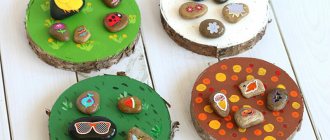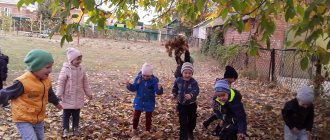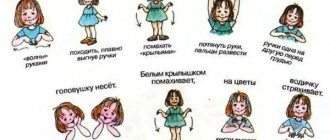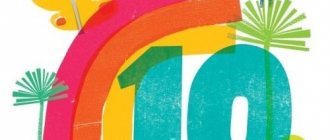MAGAZINE Preschooler.RF
Didactic game “Which tree is the leaf from?” (3-4 years)Goals of the game:
a) Didactic purpose:
- Expand children's understanding of trees
- Teach children to recognize by leaves and find different trees in the picture
- Clarify the names of trees and their parts
- Develop speech, attention, visual perception
- Enrich children's vocabulary with the names of trees and their fruits
- Develop fine motor skills of hands
b) Game goal:
- Play a didactic game
- Choose the right leaves for each tree
- Indicate the names of the trees to which the leaves are selected
Rules of the game:
— Number of players: from 1 to 7 people
— Game type: board
— The game continues until leaves for all the trees are found.
Attributes for the game:
— Cards with images of various trees: birch, chestnut, maple, etc.
— Chip cards with textile fasteners ( “Velcro” ) with images of leaves of different trees (correspond to tree cards)
Game actions and game content:
The game is played to consolidate knowledge of trees and their structure.
sticky chip cards , each of which corresponds to a specific tree.
There are two options for playing the game:
1) According to the lotto principle
The participants are given tree cards, and the presenter takes chips out of the box one after another, showing the leaves depicted on them. The player who discovers that the leaf fits his tree takes the chip and attaches it to his card. The first one to collect all the leaves and correctly name the tree wins. If there are more than two players, the game continues until there is only one loser left.
2) Independent game
Participants are dealt cards, and pre-mixed chips are laid out on the table. The players’ task is to independently find all the leaves for their tree and attach them to the card. The game is played “for a while” or for educational purposes - to consolidate the names of trees and their structure in memory, as well as learn to distinguish between different types of trees.
Game result:
— The teacher determines whether the child knows the names of trees, whether he can identify them from a picture, whether he names trees on cards and whether he knows what their leaves and fruits look like.
- It is indicated that the child played a didactic game, correctly/incorrectly matched the leaves to the tree, learned to identify trees from the image and name them.
| Next > |
Didactic game
Group:
4-5 years
Kind of activity
: didactic game.
Subject:
“What leaf.”
Educational area:
cognitive development, social and communicative development, speech development.
Forms of organization:
group, individual.
Didactic task
: improve children’s knowledge of distinguishing the leaves of three trees.
Game task
: tell the teacher about the leaves of the trees.
Game rules
: take a leaf out of the box, correctly name which tree the leaf is from, correctly name which leaf. Help each other in case of difficulties, do not interrupt each other.
Game actions
: naming which tree the leaf is from and which leaf.
Target:
development of curiosity and activity in the process of joint gaming activities.
Planned result:
- Show respect towards others.
- Show interest in gaming activities.
- Show curiosity and initiative.
- Demonstrate the ability to analyze and evaluate the achievement of a game goal.
- Demonstrate the ability to follow the rules of the game.
- Show knowledge about tree leaves (rowan, birch, apple tree).
- Demonstrate the ability to form adjectives from nouns.
| Tasks | Tasks taking into account the characteristics of the group’s students |
| Educational tasks :
Developmental tasks:
Training tasks:
| Sasha - teach how to form adjectives from nouns. Masha - to cultivate a respectful attitude towards others. |
Principles of preschool education (FSES):
1) building educational activities based on the individual characteristics of each child, in which the child himself becomes active in choosing the content of his education, becomes a subject of education (hereinafter referred to as individualization of preschool education);
2) assistance and cooperation of children and adults, recognition of the child as a full participant (subject) of educational relations;
3) supporting children’s initiative in various activities;
4) the formation of cognitive interests and cognitive actions of the child in various types of activities;
5) age adequacy of preschool education (compliance of conditions, requirements, methods with age and developmental characteristics).
Principles of education:
formation of a personal style of relationships with peers and teachers; creating a positive emotional background and an atmosphere of emotional uplift; education through interaction.
What tree is the leaf from?
Ekaterina Oleynik
Interactive game “Which tree is the leaf from”
Interactive game for preschool children “ Which tree is the leaf ”
Purpose of the game: to ensure the development of children’s ability to use ICT tools in gaming activities. Contribute to expanding knowledge about the trees of our strip . Ensure the development of children's ability to select leaves from trees .
Fix with children the names of trees , the appearance of leaves , fruits;
develop attention, observation, memory. Cultivate cognitive interest .
" Which tree is the leaf "
– educational
game for children from 4 years old . play it alone or in a small group. The game is very educational , it is good to use it for activities to familiarize yourself with the outside world in kindergarten or at home.
Progress of the game: Invite the child to name the tree , pick up a leaf for this tree and click the mouse . At the same time, explain to him that if the piece of paper is chosen incorrectly , it will remain in place and sway. If the leaf is chosen correctly , it will move towards this tree .
Attached files:
| int-igra-s-kakogo-dereva-listok_7mae0.pptx | 4648.34 KB | Downloads: 887 |
Presentation game “From which tree are the fruits” Objectives: clarifying children’s ideas about trees and their fruits; expansion and activation of the dictionary on the topic; formation of relative adjectives;
Didactic game “Which tree is the fruit from?” I bring to your attention a game for preschoolers. This game will help educators and parents consolidate children's knowledge about fruit trees and.
Didactic manual doll Oktyabrina and the game “Guess the leaf” for senior preschool age Hello, dear colleagues! I would like to present to your attention an unusual doll “Oktyabrina”, which I made myself. In my opinion c.
Interactive Game Goal: to develop verbal and logical thinking, the ability to classify, compare, generalize, establish cause-and-effect, logical.
Interactive game “Where is the logic” A distinctive feature of our time is the rapid entry of information technology into all spheres of life. Modern children, k.
Interactive game on ecology Goal: expanding environmental horizons Objectives: • familiarization with the culture and nature of the native land, • development of cognitive interest.
Interactive game “Professions” The game consists of game tasks. Selecting the correct answers in each task is done by clicking on the pictures. Right and wrong.
Summary of an autumn walk “What tree is this leaf from?” Autumn walk “Which tree is the leaf from?” Author: teacher Lukinova S. Yu. Purpose: to continue acquaintance with maple, highlighting the characteristic ones.
Master class on making a tree of happiness, a tree of wishes “Topiary” The last month of autumn has arrived, the rains have become more frequent, the temperature has dropped, people have warmed themselves. And how good it was in the summer - sun, sea, beauty.
Outdoor game “Which tree is the leaf from”
The presenter displays 3 models of wood: maple, oak, birch. Each child has a piece of paper in their hands. To the music, children run in a circle after each other, then spin. When the music ends, the children run up to the corresponding tree and squat down. The presenter checks whether the task was completed correctly. Then the children can exchange leaves. Tree layouts can also be swapped. The game is repeated again.
Outdoor game “Let’s collect a bouquet of leaves of the same color”
Children run around the hall to cheerful music; when the music ends, they squat down. The presenter at this time raises a leaf, for example, yellow, to the top, and then the children who have yellow leaves in their hands run up to the leader and join their hands with the leaves into a bouquet. Then the music starts again and the children scatter around the hall.
The game is repeated as many times as there are leaf colors (you can use red, yellow, green and orange leaves). At the end of the game, the children give the leaves to the leader.
Outdoor game “Let's collect mushrooms”
Mushrooms are laid out in a circle on the floor (the number of mushrooms is less than the number of children). Children walk in a circle saying:
We're going, we're going, we're going,
We'll find mushrooms now
Under a leaf, under a blade of grass,
On a stump, under an aspen tree.
Here's a mushroom, don't yawn
And grab it quickly!
As soon as the last words are spoken, the children must quickly take any mushroom.
You can use music. To the music, children run merrily in a circle; when the music stops, each child must take a mushroom. Whoever doesn’t get a mushroom leaves the game and sits on a chair. The last child is the winner.
Outdoor game “Fruits for compote”
You will need 3 hoops of different sizes - these are jars. The presenter calls the children at will, puts headbands with images of fruits on their heads. Invites them to take a place in a large bank. To do this, first the leader places a large hoop on the floor. Fruits move around the hall to the music. When the music ends, the fruit takes up space in the jar. Whoever does not have enough space is eliminated from the game. The presenter praises the fruits that went into the first jar. The game is repeated again, the leader removes the large hoop and puts in a medium-sized hoop. You can invite others to play the game. The third time, the hoop is placed in a small size and the third jar is filled with fruit.
Outdoor game “The potatoes crumbled”
The driver is selected, he can sit on the bench. The participants of the game stand in a round dance. This is a potato (you can use headbands with a picture of a potato). Children walk in a circle and say the words:
Oh, you potato, you potato,
You feed honest people,
If there are potatoes in the house -
You'll be full all year round!
The presenter says:
And if the potatoes crumble, what should you do?
After these words, the participants scatter, the potatoes seem to crumble. The driver catches up with the children. He takes those whom he has caught up to his bench, as if collecting potatoes. The game repeats itself again. You can choose another child to play the role of driver.
Outdoor game “One-two-three! Collect the leaves!
Leaves are scattered on the floor. Children go for a walk to the music. When the music stops, the presenter gives the command to collect the leaves. For example: “One-two-three! Collect maple leaves!” or “One-two-three! Collect yellow leaves!” Command options can be varied, focusing on size, color, and type of tree. Each time after checking the completion of the task, the children give the leaves to the presenter. He scatters them again. For the last time, the leaves are placed in a basket and removed.
Creative task
"Color the Leaves"
The presenter invites the children to paint the leaves with autumn colors using cotton swabs. To do this, you will need leaf templates that can be mounted on 3 easels. It is necessary to select patterns of maple, oak and birch leaves. You can ask the children which tree the leaves come from and what paints will be needed to paint them. It is recommended to use large templates so that each child has enough space for creativity. Children should be divided into 3 groups accordingly.
Logorhythmic exercises









